| This article needs additional citations for verification. Please help improve this article by adding citations to reliable sources. Unsourced material may be challenged and removed. Find sources: "Police vehicles in Japan" – news · newspapers · books · scholar · JSTOR (May 2023) (Learn how and when to remove this message) |

Police vehicles in Japan are vehicles used by Japanese prefectural police for patrolling, consisting of a variety of vehicles depending on the environment and situation. Most police vehicles in Japan are manufactured by domestic automakers such as Toyota, Nissan, or Subaru.
The formal Japanese term for a police vehicle is keirasha (警邏車), but the term patokā (パトカー), an abbreviation of "patrol car", is also widely used. The acronym "PC" is commonly used in police terminology (including over the radio).
Overview
Unlike how some departments in the U.S. and Canada allow their officers to take home their police vehicles, Japan does not allow officers to take home any kind of law enforcement vehicle. Every marked police car uses a black-and-white two tone livery, and police motorcycles are usually all white. Riot police vehicles are painted blue and white, and TMPD rescue vehicles are painted green and white.
Unlike fire trucks and ambulances, patrol cars often seen in the city are operated as mobile regional police units. They actively patrol the city to detect and prevent crimes and accidents rather than waiting at police stations, and are prepared to quickly arrive on scene whenever an emergency call is made. In addition, both traffic police and criminal police units do not only carry out police operations and investigations in the city, but also serve an operational purpose to quickly reach a scene from within the city.
History

The beginning of police cars in Japan is said to be at the Asakusa police station in January 1949 (Shōwa 24). Following post-WWII turmoil, security in Japan was poor, with many robberies and thefts. Therefore, the local municipal police at the time painted a US military-sourced car as a trial "mobile police" (移動警察, idō keisatsu) vehicle.
In June 1950 (Shōwa 25), the Tokyo Metropolitan Police Department deployed three so-called patrol cars, which were modified sedan-bodied WWII-era Nissan 180 truck chassis with radios. As the Korean War broke out at around the same time, the Japanese Red Purge became popular under the MacArthur Directive, and the role of the municipal police increased.
These first three police cars were of poor quality with a harsh ride, and broke down frequently. As a result, subsequent police cars were based on Ford and Chevrolet models sold by the US military. Due to a stated risk of radio jamming and interception, police radios were prohibited at the discretion of the Supreme Commander for the Allied Powers, so police cars often got lost. VHF radios were finally allowed from the late 1950s.
In the 1960s, when the quality of domestic cars began to rise, police cars also began to be based on new domestic models, such as the Toyota Crown-based Toyota Patrol. The Nissan Cedric and Isuzu Bellel were also adopted as base vehicles for police cars, and before long, only domestic models were used as police vehicles.
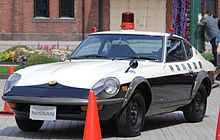
When the expressway system opened, sports cars were adopted as base vehicles for police cars. Cars such as the Nissan Fairlady Z and the Mazda Cosmo Sports were involved in speed control on expressways. In urban areas, where illegal parking became a problem, police kei cars, commonly known as mini-pato (ミニパト), begun to play an active role. Mini-pato base cars included the Suzuki Fronte and the Daihatsu Fellow Max, and they were mainly driven by female police officers (婦警, fukei).
From the end of the 1970s to the 1980s, foreign police cars reappeared in small quantities. The Porsche 911 and BMW 3 Series were painted in black and white as marked cars, and the Mercedes-Benz W124 was deployed as an unmarked car. The most notable and famous of these is probably the Niigata Prefectural Police's 1978 Porsche 911SC. This model, which was first deployed when the Hokuriku Expressway opened, has also been used as a PR vehicle for the prefectural police and has been in use for over 20 years, which is very unusual for a police car in Japan.
Livery
Shortly after WWII, some municipal police units used jeep-type vehicles painted white for transportation. However, since roads at that time were unpaved and most of the domestic vehicles then were painted white, the vehicles were heavily damaged and polluted, as well as not easily identified. As a solution, American police cars were used as a reference. The sides and front of the body, which easily got dirty, were painted black, the roof was left white, and the hood was either painted black or white to easily be able to identify police vehicles. This led to the black-and-white two-tone police livery that is used in Japan to this day. However, the modified Nissan 180 that was first deployed used a white-and-green (some say white-and-blue) two-tone pattern, also similar to American police cars of the time. It was only in 1955 (Shōwa 30) that the black-and-white two-tone livery was made a nationwide standard.
Design
Regarding the car's livery, the National Police Agency stipulates that "the body is to be painted in black and white, equipped with red warning lights and loudspeakers on the top (roof) and front, and the name of the prefecture is to be written on the side''.
As stated above, in 1955 (Shōwa 30), in order to distinguish police vehicles from other cars which were mostly white at the time, the lower half of the body was colored with black paint to make damage and dirt less noticeable. However, there are no detailed regulations at the national level, and each prefectural police force has slight differences in the livery and emergency lighting, among other details.
Livery design
The Japanese-language text on the sides usually takes the form of the name of the prefecture, followed by the suffix fukei (府警), ken-kei (県警), or ken-keisatsu (県警察) (e.g. Osaka-fukei (大阪府警) and Kanagawa-ken-keisatsu (神奈川県警察)). Whether a Mincho or Gothic typeface is used also varies between prefectures. Currently, only a few departments, such as the Kagoshima Prefectural Police and the Kumamoto Prefectural Police, use a Mincho typeface. The Gifu Prefectural Police is the only department in Japan that has their department name written in white on the bottom of the front door for only expressway patrol units, replacing the "POLICE" notation. The Aomori Prefectural Police has a white swan illustration on the bottom of the front door.
Lighting
Police cars are not equipped with red warning lights and sirens specifically because they are police vehicles, but rather emergency vehicles in general, as stipulated by the Road Traffic Act.
Normally, it is customary for marked patrol cars in charge of leading the Imperial motorcade to have one side of the lightbar changed to blue, but in recent years, the red lights have been left as they are and a detachable streamlined blue warning light became mainstream instead. In December 2008 (Heisei 20), when guarding the China-Japan-South Korea Summit Meeting held in Fukuoka Prefecture, each country's police cars were equipped with warning lights of different colors for identification purposes. South Korea used red and blue warning lights, Japan used red and blue front warning lights, and China used red and green warning lights. The Ōita Prefectural Police used to have cars equipped with American-style red and blue warning lights, but these vehicles were only used for guarding the Imperial House. In addition, some police cars used by United States Forces Japan are equipped with red and blue lights.
In 2007, the Tokyo Metropolitan Police Department decided to implement a yellow reflective material for the "POLICE" lettering on the sides and rear bumper, to make police cars more easily recognizable to foreigners and improve visibility.
Engines
Police cars differ in displacement and output depending on the type and purpose. Standard police cars generally have 2.5–1.9 L (152.6–115.9 cu in) engines, mini-pato cars have 0.66–1.5 L (40.3–91.5 cu in) engines, and expressway patrol cars have 2.0–3.0 L (122.0–183.1 cu in) engines. For this reason, vehicles are largely restricted to their initial departments, so new orders are placed for dedicated vehicles for each purpose. However, there are cases where sports cars are acquired by donation or ordered by the prefectural police, and among them, the Nissan Fairlady Z has a track record of all generations having been made into police cars.
Unit numbers
Many police cars have the name of their affiliated police station and a station-specific vehicle number written on the roof (so that it is visible to police aircraft), and the TMPD and some police headquarters also have this notation on the windshield. As an example, unit 1 of the TMPD's Kōjimachi Police Station will have "Kōjimachi 1" (麹町1) and "Kōji 1" (麹1) on the windshield and roof respectively. An expressway patrol car can be identified with signage such as "Kōsoku 3" (高速3, "High Speed 3") and "Soku 3" (速3). Each car is also assigned a prefecture-specific number used for radio communication, with, for example, a car identifying itself over the radio as unit 217.
Roof signage and radios for communication with police aircraft are mostly absent in traffic enforcement and kōban vehicles such as mini-patos. Unmarked police cars also lack roof signage to preserve their disguise.
Radio antennas
As a distinctive freature on the exterior, there are one or multiple antennas for the police radio system. These antennas are usually disguised; early on, the "F-1" antenna that imitated a personal radio antenna was used, and in the 1990s, the "TL" antenna that imitated a car phone antenna became mainstream. This was in turn followed by the "TA" antenna that is disguised as the diversity antenna of an in-car analog TV since the early 2000s, the "Euro" film antennas adjusted to the frequency of police radios, and short rod-shaped antennas (manufactured by Nippon Antenna: MG-UV-TP, WH-UV-TP, etc.), which are currently the mainstream design. Each subsequent antenna type was adopted due to the disguise becoming ineffective as in-car technology evolved. However, as an exception, some prefectural police cars use antennas disguised as amateur radio whip antennas.
Types
Japanese police cars are mainly divided into marked police cars (equipped with a two-tone livery and either a red rotating lightbar fixed to the roof, or a single deployable red rotating light) and unmarked police cars (equipped with a deployable red rotating light that can be hidden or stowed away).
Standard cars
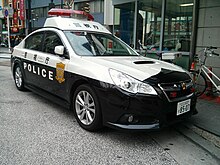
A standard police car is operated by one or two uniformed police officers. This is the most common and numerous patrol car in the Japanese police force, and it is mainly used in local police activities, the deterrence of collisions and traffic violations, and the investigation and crime vigilance activities of the detective department. When tailing a suspect in a criminal investigation, it is necessary to conceal the identity of the police from the suspect, so an unmarked car is used, but other police activities are carried out in an easily identifiable marked car.
Each car is assigned not to an officer, but to one of a number of departments, including mobile patrol, traffic enforcement, and expressway patrol. There are about 9,000 police cars that have been purchased with national funds and are deployed in various places nationwide, excluding unmarked cars.
As of 2022, the Toyota Crown is the most common marked police car in each prefecture, though the Yamanashi Prefectural Police uses the Toyota Mark X. The previously common Subaru Legacy is on the decline. In addition, the Saitama Prefectural Police uses the Nissan Teana as their patrol vehicle.

High-performance cars

Some prefectural police forces have operated numerous high-performance police cars in their fleets, with a notable example being the Tochigi Prefectural Police. High-performance cars operated by these forces include the Nissan Skyline GT-R (R34), Nissan GT-R, Subaru Impreza WRX STI, Honda NSX, Nissan 370Z, and Lexus LC 500. Alongside regular use for traffic enforcement on the various expressways of Japan, these cars are often used for publicity and ceremonial purposes. On some occasions, such cars have been donated to prefectural police forces by either private owners or vehicle manufacturers.
Throughout the 1960s and 1970s, Japanese police used Ford Mustangs such as the Ford Mustang Mach 1.

Mini-pato cars
Mini-pato (ミニパト) cars, named for being miniature patrol cars, are vehicles within the kei or "5-number" (roughly compact-sized) size classes of cars, with a maximum engine displacement of 1,500 cc or less and a maximum total length of 4,500 mm (180 in). There are exceptions such as the Suzuki SX4 and Suzuki Baleno, both "3-number"-sized cars with a total width exceeding 1,700 mm (67 in).
Mini-patos come in marked and unmarked variants, and are often deployed at kōban or police stations relatively far from the main station, or used exclusively for parking and traffic enforcement. The former, called "compact patrol vehicles", were deployed for the first time in 1974 to 100 police stations with severe road and weather conditions nationwide (Shōwa 50 edition "White Paper on Police"). A large number of 1,000-1,500 cc compact cars were introduced by the National Police Agency and deployed nationwide, and are now a common sight on the streets of Japan.
As mini-patos are not equipped with radios or radar systems, police officers riding in them are required to carry portable radios or radio receivers. However, antennas are installed in many mini-patos, and are meant to be connected to an officer's portable radio. Some vehicles are equipped with data communication terminals and location tracking systems. The equipment present on the base car is left as it is, so factory-equipped navigation systems may be present, but are seldom used due to the operational environment. In addition to the standard V-shaped light bar found on standard police cars, mini-patos are also equipped with an auxiliary red warning light.
On occasion, prefectural vehicle procurements may differ from those at the national level. Whereas national mini-pato orders are often for kei cars due to their maneuverability on cramped and congested urban roads (particularly in Tokyo), prefectural police in less urbanized areas may opt for so-called liter cars, taking durability into account because of larger operation areas and thus longer travel distances. Since most orders are from prefectural governments, there is no single standardized model nationwide.

Examples of nationally-funded mini-patos
- Toyota Passo (2007-2009, 2012)
- Toyota Platz (2001, 2004)
- Honda Insight (2009)
- Suzuki Swift (2000, 2002-2003, 2005, 2015, 2018-2020)
- Suzuki Solio (2006-2007, 2009, 2011, 2013-2014, 2017)
- Nissan Note (2022)
Examples of prefecture-funded mini-patos
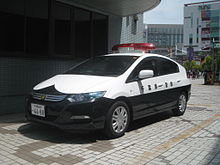


- Daihatsu Atrai 7
- Daihatsu Be-go
- Daihatsu Boon
- Daihatsu Rush
- Daihatsu Sharade Social
- Daihatsu Storia
- Daihatsu Terios (J100/F500) / Toyota Cami
- Daihatsu Terios Kid (kei car)
- Daihatsu Thor / Toyota Roomy / Toyota Tank / Subaru Justy (2nd-gen)
- Honda Vezel
- Nissan Cube
- Nissan March
- Nissan Note
- Nissan Pulsar Sedan (N14/N15)
- Nissan Sunny (FB15)
- Nissan Tiida Latio
- Mazda Demio
- Mazda Familia Sedan
- Mitsubishi Colt
- Mitsubishi Lancer sedan (excluding Sedia)
- Mitsubishi Toppo BJ (kei car)
- Suzuki Kei (kei car)
- Subaru Impreza (GD) sedan (1.5L model only)
- Subaru Pleo (RA1/RA2/RV1/RV2)
- Suzuki Aerio hatchback / sedan
- Suzuki Baleno (3-number car)
- Suzuki Cultus Crescent
- Suzuki Hustler (3-number car)
- Suzuki Ignis
- Suzuki Jimny Sierra/Jimny Wide
- Suzuki SX4 hatchback / sedan (3-number car)
- Suzuki Xbee
- Toyota Belta (NCP96)
- Toyota Corolla Axio (NZE164)
- Toyota FunCargo
- Toyota Ist
- Toyota Starlet
- Toyota Vitz (KSP90/NCP95)
- Mazda Demio
- Mazda Axela (BK) sedan (3-number car; 1.5L model only)
Common urban mini-patos
- Daihatsu Mira (including Mira Gino, Mira e:S, Mira Tocot)
- Daihatsu Esse
- Daihatsu Cast Style
- Mistubishi Minica
- Suzuki Alto (including Alto Lapin)
- Suzuki Every

Unmarked cars
An unmarked police car, or fukumen-sha (覆面車, "masked/disguised car"), has the same default appearance as a normal civilian car, with hidden emergency lighting being deployed in the event of an emergency. In Japan, unmarked cars are used for traffic enforcement, escorts, and criminal investigations. The officers within may be wearing uniforms or plain clothes depending on the assignment.
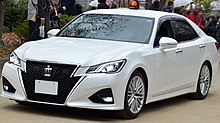
Unmarked cars' emergency lighting is generally in the form of a single red rotating beacon light stored under a panel in the roof of the vehicle that electrically rotates into place when needed, leaving a recess in the roof (sometimes called a "washbowl" (洗面器, senmenki) due to its shape). Early on (i.e. in the 1960s), this light only ascended and descended into position and did not rotate. Some unmarked cars use a magnetic beacon light that is manually attached to the roof of the car,and others have an electronic display board visible through the rear window that can display messages such as "FOLLOW ME" or "SLOW DOWN".
Unmarked cars, like marked cars, have different specifications for different purposes. However, since there is less demand for unmarked cars than marked cars, there are fewer models, and currently only the Toyota Crown is identified as a regular catalog model. However, as with marked cars, the majority of vehicles are purchased by prefectural police, purchased in bulk by the National Police Agency through general competitive bidding, or donated (as with high-performance marked cars), so there are also many unmarked cars based on general civilian vehicles. During the bubble economy, in order to reduce the trade surplus, there were cases in which foreign luxury vehicles such as Mercedes-Benzes and BMWs were purchased with government funds and deployed as expressway patrol units.
The Toyota Mark X pictured above cost ¥33,311,640 for 4 units (¥8,327,910 or roughly US$71,200 per unit) to purchase in 2016. It is a performance model equipped with a special supercharged 3.5 L (210 cu in) Toyota 2GR V6 engine with a torque and horsepower increase over a standard 2GR.
-
 A Toyota Crown with an "auto-cover" warning light in the front bumper and "TA" antennas on the left and right sides of the upper rear window
A Toyota Crown with an "auto-cover" warning light in the front bumper and "TA" antennas on the left and right sides of the upper rear window
-
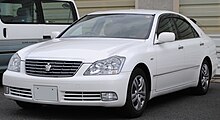 A Toyota Crown with warning lights in the front grill and "TA" antennas on the left and right sides of the rear window
A Toyota Crown with warning lights in the front grill and "TA" antennas on the left and right sides of the rear window
-
 A TMPD Toyota Crown for traffic enforcement with "TA" antennas
A TMPD Toyota Crown for traffic enforcement with "TA" antennas
-
A Toyota Crown with warning lights in the front grill and a "Euro" antenna
Notes
- In some areas, cars have been modified into unmarked traffic enforcement cars (e.g. a Y31 Nissan Cima of the Shizuoka Prefectural Police expressway patrol department).
References
- 『広辞苑』第六版「パトロールカー」、『明鏡国語辞典』第二版「パトロールカー」。
- ^ デジタル大辞泉「パトロールカー」
- "警察のホント・ウソ - 岡山県警察 採用情報 - 岡山県ホームページ(警務部警務課)". www.pref.okayama.jp. Retrieved 17 February 2019.
- ^ "昔は「白」だった!! パトカーの白黒パンダカラーはいつから始まった". 自動車情報誌「ベストカー」 (in Japanese). 26 July 2021. Retrieved 4 May 2023.
- ^ "警察車両(パトカー)の歴史 | 名車文化研究所". meisha.co.jp (in Japanese). Retrieved 4 May 2023.
- ^ "別冊ベストカー". 平成〜令和新時代 パトカー30年史 (in Japanese) (2nd ed.). Kodansha. 3 December 2022. p. 32. ISBN 978-4-06-515554-7.
- 交通タイムス社. "緊急走行できないパトカーがあった! 軽やコンパクトカーベースの「ミニパト」の仕事とは". WEB CARTOP (in Japanese). Retrieved 7 May 2023.
- ^ 『朝日新聞』「しつもん!ドラえもん」(Unknown date)
- ^ "パトカーの沿革(警察の歴史-制服、パトカー、白バイ)". 警視庁. Retrieved 1 February 2018.
- "パトカーのドアに全国唯一のビッグマーク 「らしさ」貫く青森の警察車両 県警に聞いた". 乗りものニュース (in Japanese). Retrieved 9 May 2023.
- パトカー側面に「POLICE」文字 視認性向上へ 共同通信(2007年2月8日)
- ^ "警察マニア予備軍以外、誰得!? 細かすぎる覆面パトカーの見分け方". 自動車情報誌「ベストカー」 (in Japanese). 11 November 2021. Retrieved 12 May 2023.
- "パトカーの装備(無線アンテナ)". policecar.nomaki.jp. Retrieved 12 May 2023.
- ^ 【ニュースの門】パトカー不審者は見逃さぬ『読売新聞』朝刊2021年4月13日(解説面)
- Okulski, Travis (6 December 2018). "Japan's R34 Skyline GT-R Cop Car Is Real and Spectacular". Road and Track. Retrieved 18 June 2023.
- McEachern, Sam (15 June 2018). "Japan Just Put an R35 Nissan GTR Police Car Into Service". AutoGuide. Retrieved 18 June 2023.
- Takuji Hiraga (2 January 2022). "Tochigi police use luxury, speed of patrol fleet to promote safety". The Asahi Shinbun. Retrieved 18 June 2023.
- McAleer, Brendan (6 December 2018). "American icon in a foreign land: Japan's police-spec Tochigi Mustang Mach 1". Hagerty Media. Retrieved 23 August 2024.
- KBCアーカイブズ九州朝日放送
- ニッポン警察史上“最速覆面パトカー”の正体は「スーパーチャージャー搭載360馬力の本気仕様マークX」 日刊SPA!(2017年2月26日)2017年2月26日閲覧